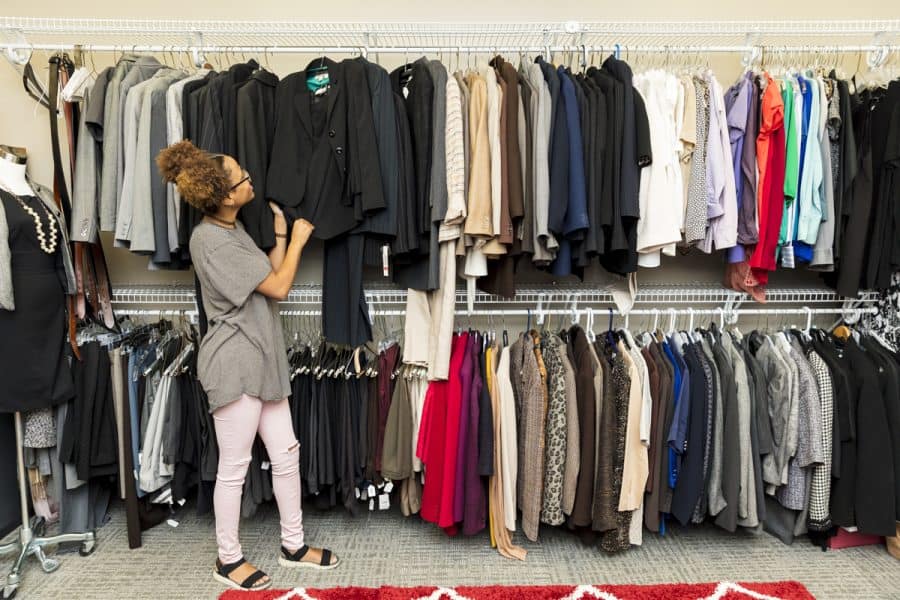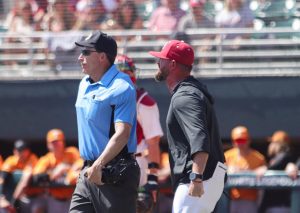A guide to dressing professionally on a cramped college budget
Courtesy of the UA Career Center
Student showcasing the selection of professional dress options at Crimson Closet.
March 1, 2023
Students always hear not to dress for the job you have, but the job you want. While many college students see the required professional dress for events and interviews to be burdensome due to the expensiveness of items such as full suits and blouses, there are ways to dress for success without breaking the bank.
Typically, jobs come with either a business professional or business casual dress code. A business professional dress code typically includes items such as full suits and blouses. For a feminine look, dresses with blazers are also allowed. Additionally, business professional dress codes usually require more neutral color palettes.
For example, for an event that requires a business professional event, one might choose to wear a full black suit with sensible shoes and neutral colors. Additionally, a tie is added to the suit for an added touch.
On the other hand, business casual dress codes include the items above, but tend to be more lenient. For the casual dress code, brighter colors are allowed. Also, one can wear cardigans instead of blazers. Many business casual dress codes allow for more creative freedom in the choice of dress.
A few examples for business casual could be the addition of fun jewelry, bright or pastel colors and tasteful patterns. Additionally, a tie is typically not needed for business casual.
Laura Thomas, the director of professional development for the Division of Student Life, said she believes that when students are looking for jobs, they should keep in mind the lifestyle they’d like in their future careers.
For example, if a student is looking for a career with a more lenient dress code that doesn’t require a suit every day, they should keep that in mind when choosing a career.
“I definitely think there’s plenty of different types of workplaces out there and depending on the students or the job applicant search and what they’re looking for, they can find a workplace that reflects the attire,” Thomas said.
On one hand, jobs in fields such as finance will have a stricter dress code with a heavier emphasis on wearing neutrals, while a fashion career may allow for a more colorful, varied wardrobe.
“Typically, positions that are more artistic and creative allow for a little more freedom to express personality,” said Brian Taylor, an instructor in the clothing, textiles, and interior design department. “It really depends on your position and the company you work for. I’ve worked for a variety of company sizes, and they each had their own dress code.”
Additionally, the amount of professional clothing one needs can change based on necessity. For instance, Thomas said a college student just going to a career fair is going to need much less than an individual who works in an office daily.
Kimbrel Hinds, a junior majoring in apparel and textiles with a concentration in retail and sales, said she believes in the power of buying basics. Hinds recommends one full suit, two undershirts and a pair of business shoes because of the outfit flexibility that these items offer.
“With a full suit you can take the jacket off and wear the shirt and pants, and that’s business casual. Then you have shirts to choose from,” Hinds said. “Then put the jacket on, it becomes a full suit. If you want to have business casual, wear jeans, a blazer and a business shirt.”
After deciding what to buy, students should consider where they’re buying clothes from. It all depends on their budget. For example, the Crimson Career Closet is a free resource to all students at the University and allows students to rent out professional dress for free for any project, interview or event they may need it for.
When buying your own clothes, though, hunting for discounts can be useful. When dressing professionally, it’s about finding clothes that look and feel good, as opposed to just following the latest trends.
“I usually go to department stores like Belk, Dillard’s, JC Penney, Macy’s, and I usually go to the clearance section first,” Hinds said. “People in the business world don’t necessarily care about the season of clothes you’re wearing, so I’m able to easily go into Belk and go to the clearance section and find things from last fall, or this fall, and it looks totally great.”
Another way to find quality clothes for less is to check out stores that sell overstock, such as TJ Maxx and Ross. Stores like these are great options because you can find high quality items for lower prices.
In the modern world of dressing professionally, more economically friendly brands have also caught onto the demand of dressing on a budget. Retailers like Amazon and Target have professional clothing lines that come with less daunting price tags and act as great duplicates for big name brands. Another great place to find quality clothes for affordable prices are thrift stores.
It is important to keep in mind while shopping that some articles of clothing and accessories warrant larger investments compared to others. Shoes are an accessory that can be worn with a wide array of outfits, meaning that buying a pair that will not only match multiple things but also are durable is crucial.
“Invest in quality shoes first. Shoes are a good way to show your personality, and the quality shows you care about how you present yourself,” Taylor said. “Make sure the shoes you wear are comfortable and you can walk in them without looking awkward.”
In addition to buying a high quality pair, it’s necessary to take care of them due to the high investment.
“For an interview, polish your shoes, and a good tip I follow is to clean the bottom of your shoes,” Taylor said.
When purchasing professional clothes, students should also pay attention to the types of fabrics.
“Look for fabrics that are breathable and allow you to feel comfortable. You don’t want to appear hot or bothered by the type of fabric you are wearing,” Taylor said. “Many dress shirts now have moisture wicking qualities and cooling properties to help you feel more at ease when wearing.”
While there are rules to dressing professionally, it can also be a great way to show off one’s personality.
After mastering the basics of professional dress, then comes the understanding of our ever-changing professional world. As time has gone on, standards of what qualifies as professional dress have drastically changed.
Thomas said in earlier generations, young professionals were accustomed to wearing a suit and tie every day. However, in the more modern generation, dress codes have loosened to adjust to a progressive generation.
Thomas said that many employers are trying to balance employee satisfaction and retention with their own professional expectations, so some are moving away from traditional workplace attire.
“I think nowadays we see professionals, bosses and supervisors approaching more to dress for the day that you have,” Thomas said. “I think we’re still seeing trends that are veering away from the traditional, especially gender norms and things like that to maybe a more inclusive and progressive workplace.”
The pandemic has also had a major impact on the dress codes for professional workplaces.
“The pandemic made us realize that life happens outside of work. I think that the pandemic opened the door for a little more conversation about what employees need and what brings people satisfaction and adds value to their life,” Thomas said. “I would say there’s a little more consideration for what the employee needs are and maybe that’s in the version of a casual Friday, because it’s rewarding.”
At the end of the day, the most important thing to keep in mind is that you find clothes that fit well and that you feel comfortable in.
Thomas said a common mistake that college students make when preparing to dress professionally is wearing clothes that don’t fit. Ensuring that garments fit comfortably is key to finding items that will last a long time.
“If your clothes don’t fit, whether they’re borrowed from a friend and they’re too big or too small, then that makes the person wearing them uncomfortable, and that makes everybody else uncomfortable,” Thomas said. “Ultimately, you just don’t communicate as effectively and so you want to find something that fits and makes you feel good.”





















![UPDATE | New details have emerged about U.S. Immigration and Customs Enforcement’s arrest of doctoral student Alireza Doroudi.
— Yesterday, a University spokesperson confirmed that a doctoral student was arrested by federal immigration authorities, without providing the student’s name, declining to share specific information due to federal privacy laws.
“International students studying at the University are valued members of the campus community, and International Student and Scholar Services is available to assist international students who have questions,” said Alex House, associate director of media relations for the University. “UA has and will continue to follow all immigration laws and cooperate with federal authorities.”
— An employee at the Pickens County Jail confirmed that Doroudi is being held there, adding that the facility typically sends ICE detainees to a detention facility in Louisiana.
— The Department of Homeland Security provided a statement about Doroudi’s arrest:
“ICE HSI [Homeland Security Investigations] made this arrest in accordance with the State Department’s revocation of Doroudi’s student visa. This individual posed significant national security concerns,” a DHS spokesperson said. The statement did not provide details about why it claimed Doroudi posed national security concerns.
— Students for Justice in Palestine at UA, formerly known as Bama Students for Palestine, said in a statement on social media Thursday that it was “outraged” to learn of his detainment and that he "was not involved, nor has he ever been involved in any organizing or protests related to our organization."
This is a developing story and will continue to be updated. Read the updates at the link in our bio.](https://scontent-iad3-1.cdninstagram.com/v/t51.75761-15/486944895_18492822301025566_6944596333023050206_n.jpg?stp=dst-jpg_e35_tt6&_nc_cat=107&ccb=1-7&_nc_sid=18de74&_nc_ohc=hnp26Pzwsm0Q7kNvgH09W0S&_nc_oc=AdmIBEMuR_aRgaBd00Hlot3E59Vj_4lQyCImLLgp8CLdbxpSmLU25dhU_MO_Zul-qcU&_nc_zt=23&_nc_ht=scontent-iad3-1.cdninstagram.com&edm=AM6HXa8EAAAA&_nc_gid=VJEYRWqqlhbKIBwf5vJnNQ&oh=00_AYHSiDnOPatEYtzf0n7jj1KjF5WMsVRf1hepAsIrQ24l1A&oe=67F343F0)